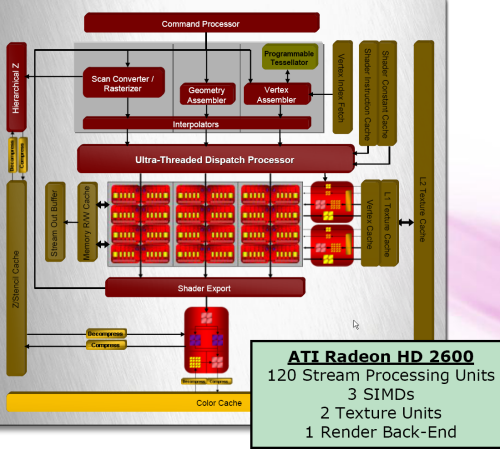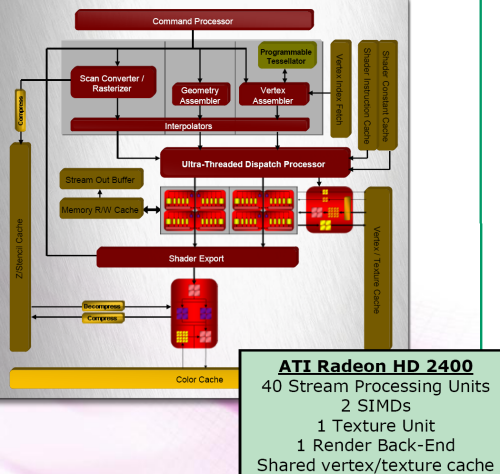Radeon HD 2600 and 2400 are born
Please read this
A word or two first about testing.AMD, in its infinite wisdom, provided HEXUS with Radeon HD 2600 XT and Radeon HD 2400 XT cards last Sunday night. The time between grabbing the hardware and publishing this review has been spent in pulling out what hair (collectively) we have left.
Short-notice, poor drivers and re-testing of copious amounts of hardware together mean that this should be considered more of an architectural-look and a performance-preview than a comprehensive, non-time-dependent appraisal of AMD's mid-range graphics technology.
Excuses out of the way!
AMD Radeon HD 2600 and HD 2400 series in detail
Today sees AMD fill out the mid-range and low-end with its DX10-supporting GPUs. Jumping straight into the proposed line-up with ye olde table, here's how they stack up against select NVIDIA SKUs.| GPU | ATI Radeon HD 2600 XT GDDR4 | ATI Radeon HD 2600 XT GDDR3 | ATI Radeon HD 2600 PRO DDR3 | ATI Radeon HD 2400 XT | ATI Radeon HD 2400 PRO | NVIDIA GeForce 8600 GT | NVIDIA GeForce 8500 GT | NVIDIA GeForce 8400 GS | |
|---|---|---|---|---|---|---|---|---|---|
| API | DX10 + SM4.0 | ||||||||
| Transistors (million) | 390 | 180 | 289 | 210 | |||||
| Manufacturing process (nm) | 65 | 80 | |||||||
| Core speed | 800MHz | 800MHz | 600MHz | 700MHz | 525MHz | 540MHz | 450MHz | 450MHz | |
| Texture units | 8 | 4 | 16 | 8 | |||||
| ROPs | 4 | 8 | 4 | Fillrate (GTexels/s) | 3.2 | 3.2 | 2.4 | 2.8 | 2.1 | 8.64 | 3.6 | 3.6 |
| Memory speed, effective (MHz) | 2200 | 1400-1600 | 800-1000 | 1400-1600 | 800-1000 | 1400 | 800 | 800 | |
| Memory Bus Width (Bits) | 128 | 64 | 128 | 64 | |||||
| Memory bandwidth (GB/s) | 35.2 | 22.4-25.6 | 12.8-16.0 | 11.2-12.8 | 6.4-8.0 | 22.4 | 12.8 | 6.4 | |
| Expected framebuffer | 256MiB | 128MiB/256MiB | 256MiB | 128MiB/256MiB | |||||
| Stream processing units | 120 | 40 | 32 | 16 | |||||
| SP frequency | 800MHz | 800MHz | 600MHz | 700MHz | 525MHz | 1190MHz | 900MHz | 900MHz | |
| MADD rate (GFLOPs) | 192 | 192 | 144 | 56 | 42 | 114.24* | 43.2* | 43.2* | |
| Video-acceleration technology | Avivo HD | PureVideo HD | |||||||
| Outputs | 2 x dual-link DVI with HDCP HDTV-Out HDMI |
1x dual-link DVI with HDCP HDTV-Out HDMI |
Dependent upon AIC | ||||||
| Expected retail price | £87 | £67 | £60 | £46 | £34 | £99 | £50 | £39 | |
* Derived by adding a MUL to the MADD.
That's a lot of numbers to digest, so let's reference them against some architectural discussion.
The following discussion assumes a basic understanding of unified shading architecture. Should that not be the case, head on over to here to learn more.
Thinking about it some, the Radeon HD 2600's architecture is, for all intents and purposes, a shrunken version of the Radeon HD 2900 XT - and in more ways than one.
The obvious chops are to the stream-processors - which offer unified shading - down from 320 to 120. Unlike NVIDIA's boosted shader clocks, AMD's operate at core speed, which is 800MHz for both Radeon HD 2600 XT models. Simple maths tells us that 120 SPs, capable of 2 FLOPs per clock cycle, operating at 800MHz, push out 192 GFLOPs. That's true for vertex, pixel and geometry shading, of course, although each constituent shares its shading resource with the others.
Radeon HD 2600 XT is endowed with only four ROPs and eight texture-filter (FP32) units. The programmable tesellator, which allows for almost 'free' geometry production and other useful gubbins, survives intact from R600 and that's good news.
But the devil is in the details that you don't see on the above overview. The Radeon HD 2600 is based on a 65nm manufacturing process (65G+) and interfaces with its local memory via a 128-bit interface.
The table shows that there will be three SKUs based on Radeon HD 2600 (RV630). The XT will be offered in variants with GDDR3 memory or GDDR4, with the latter operating at faster speeds and providing greater bandwidth. Other than the difference in DRAM used, the two XTs are architecturally identical. The GDDR4 model will carry a ~£20 price premium over its GDDR3 counterpart.
Further differentiating the line is the Radeon HD 2600 PRO. This runs with a lower core speed - 600MHz - and slower (DDR2) memory. Again, variation in speed is the only difference. It still packs in 120 SPs, a 128-bit memory interface and a 256MiB framebuffer. Price is reduced accordingly, with retail examples reckoned to be available for around £60.
Have an architecture that's cut down compared to the R600 brings down the transistor count to around 390M. Models in the Radeon HD 2600 series, obviously, are designed to compete with NVIDIA's GeForce 8600 range. A quick look at the comparative specs tells us that the HD 2600 should do well in titles where shading is called to the fore, thanks to its higher pure FLOP rate, but will suffer in scenarios where pure pixel fillrate is still the all-important factor.
Pricing, though, looks to be competitive. We're informed that the range-topping Radeon HD 2600 will debut at below £90 and, as you can see, drop to around £60 for the DDR2-equipped model.
The Radeon HD 2400 is the runt of the DX10-litter. It's designed as a low-cost solution for those looking to upgrade to DX10 visuals but hamstrung by a limited budget.
Pure processing power is hampered by it only having two SIMD arrays, with a total of 40 stream-processing units churning away. There's only a single texturing unit, meaning four texture-filter (FP32) units. And, saving space and further cost, it has just a single shared vertex/texture cache. The ROPs stay the same as the HD 2600 series, though. In comparison to the GeForce 8500GT/8400 GS, things looks pretty even on paper.
The HD 2400 also sees a split into two SKUs. AMD's kept the XT and PRO naming structure in place and, like the HD 2600 series, both are distinguished solely in terms of different clockspeeds. Remember, however, that the sub-£50 pricing will be reflected in performance. It may adhere to DX10 and be adequate at, say, 1024x768 but its architecture is such that it'll (rightfully) struggle with any serious load.
The memory interface is further trimmed to an external 64-bit. The HD 2400 series is based on the same 65nm process as the HD 2600 and also uses an advanced ringbus controller and will carry around 180M transistors, too. Summing it up, we expect to see a small-die and high-quality visual precision but low-end performance.











